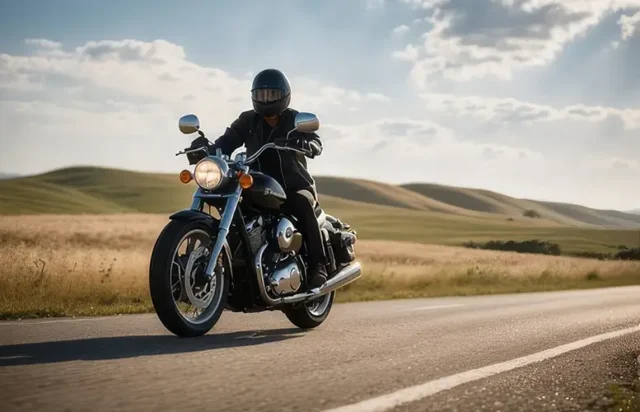
Riding a motorcycle offers an exhilarating sense of freedom and adventure, making it an appealing mode of travel for many. For beginners, understanding the basics of motorcycle travel is essential to ensuring a safe and enjoyable experience. From learning about essential gear to understanding road safety, new riders have much to discover before hitting the open road.
Choosing the right motorcycle and equipment is a crucial step. Beginners should focus on selecting a bike that matches their skill level and comfort. Equipping oneself with proper safety gear, including a helmet, gloves, and protective clothing, is non-negotiable for safe riding.
Planning a route and knowing the terrain can make a significant difference in the ease and enjoyment of a motorcycle trip. Practicing basic maneuvers and familiarizing oneself with the motorcycle’s controls are fundamental to building confidence and competence on the road.
Choosing Your Motorcycle
Selecting the right motorcycle involves considering the type of bike, deciding between new and used options, and ensuring the fit and comfort match your needs.
Types of Motorcycles
Cruisers are popular for their low seat heights and comfortable riding position. They are great for relaxed rides and long-distance travels.
Sport bikes, with their aggressive stance, are designed for performance and handling. Riders seeking speed and agility often choose this type.
Touring motorcycles offer features like large fuel tanks, ample storage, and comfortable seating, making them ideal for long journeys.
Dual-sport bikes can handle both on-road and off-road conditions, catering to those who enjoy versatile riding experiences.
Standard motorcycles provide a neutral riding position, suitable for various riding styles and skill levels. They are often recommended for beginners.
New vs. Used Bikes
New motorcycles come with the latest technology, safety features, and warranties. They require less maintenance and offer peace of mind with their reliability.
Used bikes, on the other hand, are more affordable and can be an excellent choice for beginners who want to learn without investing too much initially. It’s essential to inspect the bike’s condition and service history.
Consider financing options, as some dealerships offer attractive deals on new models. Purchasing from a reputed dealer can ensure that a used bike is in good condition and fairly priced.
Test rides for both new and used options are crucial to determine their suitability for your riding style and comfort level.
Fit and Comfort
Ergonomics is crucial. Ensure the motorcycle fits your body size and riding style. Check if you can comfortably reach the handlebars, brakes, and footpegs.
Seat height determines if your feet can touch the ground when stopped. This is particularly important for stability and confidence, especially for shorter riders.
Weight and balance affect how easily you can maneuver the motorcycle. Heavier bikes may be challenging for beginners, so consider lighter options if you’re new to riding.
Customization can also enhance comfort. Adjustable seats, handlebars, and footpegs can be tailored to fit your preferences, ensuring a personalized riding experience.
Motorcycle Safety
To ensure a safe and enjoyable journey on a motorcycle, beginners need to focus on proper gear, basic riding skills, adherence to traffic laws, and regular maintenance. This section covers the essential elements to help riders stay protected and minimize risks.
Essential Gear
Wearing the right gear is crucial for safety. Helmets are mandatory, offering protection against head injuries. Riders should opt for helmets that meet safety standards like DOT or ECE 22.05. Jackets and pants made of abrasion-resistant materials like leather or Kevlar offer added protection. Gloves protect hands from impact and provide better grip. Boots with ankle support prevent foot injuries. Reflective clothing or accessories enhance visibility, making riders more noticeable to others on the road.
Basic Riding Skills
Novice riders must master basic riding skills to ensure safety. Knowing how to balance and steer the motorcycle is fundamental. Practicing smooth acceleration and braking helps in handling the bike better. Riders should be competent in maneuvering at various speeds and taking turns safely. Training courses offered by organizations like the Motorcycle Safety Foundation (MSF) provide valuable hands-on experience. Effective communication with other road users through proper signaling is also essential.
Traffic Laws and Etiquette
Abiding by traffic laws and observing proper road etiquette enhances safety for everyone. Riders should always obey speed limits and traffic signals. Lane splitting, where legal, should be done cautiously. Using turn signals and maintaining a safe distance from other vehicles prevents accidents. Being aware of blind spots and checking mirrors regularly ensures better situational awareness. Riding defensively, anticipating the actions of others, and avoiding aggressive maneuvers contribute to safer riding practices. You can also learn more here.
Maintenance and Upkeep
Regular maintenance keeps the motorcycle in optimal condition, reducing the risk of mechanical failures. Checking tire pressure and tread helps in maintaining proper grip and control. Oil and fluid levels should be monitored and topped up as needed. Inspecting brakes, lights, and signals ensures they function correctly. The chain and other moving parts need lubrication to prevent wear and tear. A well-maintained motorcycle not only performs better but also provides a safer riding experience.





